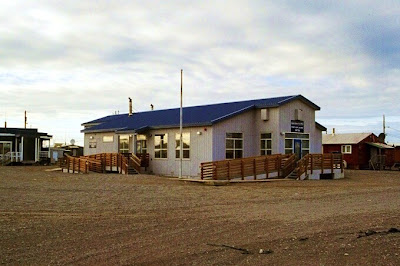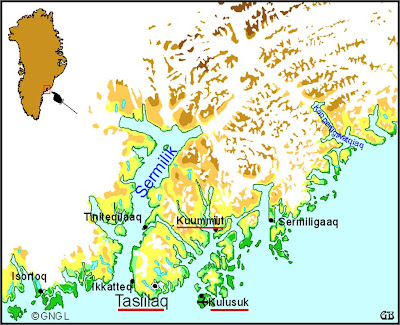 Banks Island belongs to the Arctic Archipelago, on the Canadian Northwest Territories
Banks Island belongs to the Arctic Archipelago, on the Canadian Northwest Territories
Sachs Harbor, pop. ~140
Latitude: 71° 58' N; Longitude: 125° 12' W

Sachs Harbour or Ikaahuk ("place where one crosses") is the most northerly community in the NWT of Canada. Sachs Harbour is the only permanent settlement on Banks Island, situated on its southwestern shore, and is the nearest community to Aulavik National Park. The settlement is also known as the "Muskox Capital of Canada".
It has a small airfield and terminal, a school, a nurse health center.
Sachs Harbour
The Aulavik Park
Aulavik National Park is on Banks Island, the most westerly island in the Canadian Arctic Archipelago. The Beaufort Sea lies to the west. To the northeast, M'Clure Strait separates the island from Prince Patrick Island and Melville Island.
Banks Island is tundra territory, with extremely cold winters. The island is home to barren-ground caribou, polar bears, muskoxen - 68000 muskoxen live on the island, the majority of the world's population.
The heart of Aulavik National Park is the Thomsen River. It runs through the park, and is the northernmost navigable river (by canoe or kayak) in North America.
Banks Island is tundra territory, with extremely cold winters. The island is home to barren-ground caribou, polar bears, muskoxen - 68000 muskoxen live on the island, the majority of the world's population.
Paddling on Thomsen River observed by musk-oxen.
The park encompasses a variety of landscapes from fertile river valleys to polar deserts, buttes and badlands, rolling hills, and bold seacoasts.
Arctic fox
In September 1851, Captain Robert McClure's ship, HMS Investigator, became ice trapped in Mercy Bay, Banks Island, during his search for the lost Sir John Franklin Expedition, ordered to complete a crossing of the Northwest Passage, which had already been charted from both the east and west but had never been entirely navigated.
HMS Investigator was strengthened with iron reinforcement for Arctic services; in 1848 she set sail, in search for the missing Sir John Franklin expedition in quest of the Northwest Passage: with two other lost ships, HMS Erebus and HMS Terror, it had made up the ill-fated 1845 British Arctic Expedition that failed the attempt to cross the passage through the Arctic.
HMS Erebus and HMS Terror trapped in the ice
Having only found some graves and human remains, and failed again the attempt to sail through the deep frozen Arctcic ocean, then on the return voyage, which was commanded by Robert McClure, HMS Investigator itself became trapped in the ice.
Three years later, on June 3rd 1853, her sixty-nine man crew were forced to abandon ship. She was finally abandoned in Mercy Bay, Banks Island. Most of the crew went on to survive for three winters, though in the most unimaginably desperate conditions. They were finally rescued in Melville Island.
The Investigator's remains were found on the shores of the island with the deck of the ship roughly eight metres below the surface of the water. The Canadian archaeologists found the ship "largely intact" sitting upright in approximately 25 feet of pristine arctic water.
(The HMS Erebus and HMS Terror wrecks are yet to be found)
































































